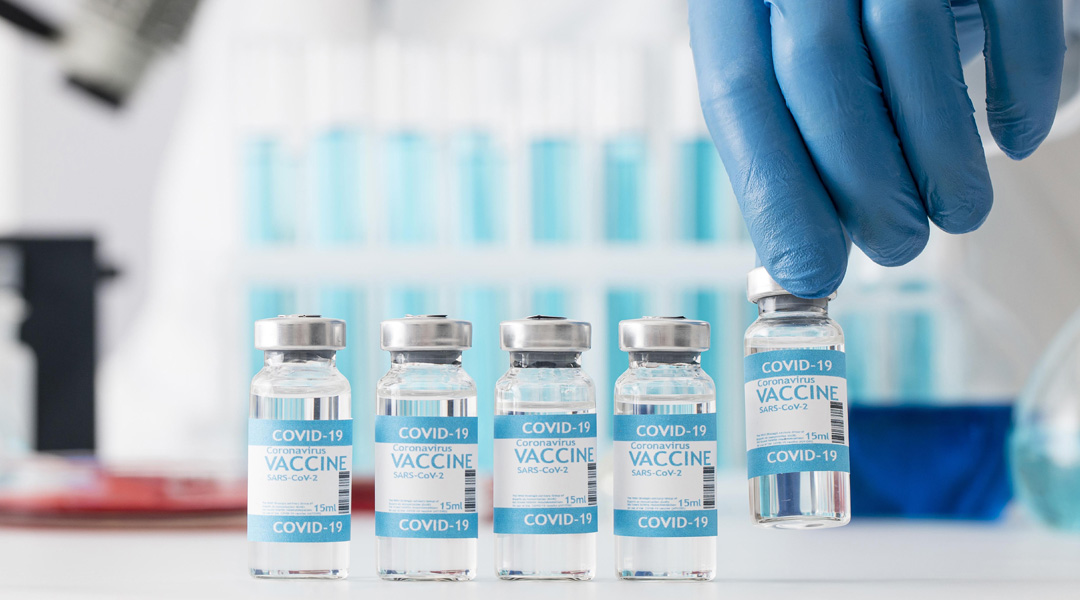Fear of needles is common worldwide and is more predictive of vaccine hesitancy than education level. According to some estimates, in the United States alone, between 11.5 and 66 million adults are afraid of needles, and that can contribute to low vaccination rates for diseases like COVID-19.
Researchers at Yonsei University in Seoul, Korea are working on a COVID-19 vaccine they say is both painless and potentially more protective against SARS-CoV-2, the virus that causes COVID-19. The vaccine is delivered via multiple dissolving microneedles instead of by traditional intramuscular injection.
Microneedles “have much smaller diameters compared to conventional syringe needles,” writes Hyungil Jung, one of the study’s co-authors. “Usually, 22-to-25-gauge needles are used for vaccination, which have 500 to 700 µm diameters. On the other hand, microneedles have 10 to 30 µm tip diameters. This is the reason why the dissolving microneedles cause less pain compared to conventional injections when inserted into the skin.”
This may sound like a great alternative for needle-fearers, but the vaccine also has an unusual delivery site—it’s sublingual, which means the microneedles are placed under the tongue. This is what gives the vaccine its increased efficacy, says Jung. A vaccine delivered under the tongue stimulates the production of immunoglobulin A (IgA), an antibody that helps prevent viruses from entering the body. On the other hand, a vaccine delivered intramuscularly stimulates immunoglobulin G (IgG), an antibody that provides defense against viruses that have already entered the body.
“Mucosal surfaces can be described as borders or frontiers where invading viruses or bacteria act as an enemy,” says Jung. “IgA is like border guards stationed at the frontier, while IgG is like an army stationed inside the borders … if IgG is present, defense against invading pathogens is possible, but without border guards, battles with antigens occur within the territory, potentially causing harm to our bodies. However, when IgA is present, it acts as an initial defense at the borders, minimizing damage that would occur within the territory.”
Jung and his co-authors say their vaccine induces both IgA and IgG, which could both protect against infection and reduce the inflammatory response post-infection. This might help prevent a severe immune reaction called a cytokine storm, which can lead to organ failure and death.
“In our research, when mucosal immunity was induced, we observed a decrease in the expression levels of cytokines, which are major contributors to cytokine storms caused by coronavirus infections,” says Jung.
Mark Prausnitz, a chemical and biomolecular engineering professor at Georgia Institute of Technology in Atlanta, Georgia, says microneedle vaccines also have additional advantages over conventional injections. “They can be painlessly administered by personnel with little training. They often enable vaccines to be stored without refrigeration and do not generate biohazardous sharps waste, like hypodermic needles do,” Prausnitz writes. “This study showed that vaccination in the mouth can generate mucosal immune responses using a COVID vaccine, but this approach could apply to other vaccines as well.” Prausnitz, who is also Director of the Center for Drug Design, Development, and Delivery at Georgia Tech, was not involved in the study.
Despite evidence that microneedles are more effective and less painful than intramuscular vaccines, this particular vaccine may still have to overcome some public resistance, especially since the area under the tongue is very sensitive. “Some patients may feel a certain level of discomfort or reluctance regarding this method,” Jung writes. “During the peer-review process of our research paper, there were discussions with reviewers about this issue … in order to enhance patient convenience, we are planning to optimize the application site by considering alternatives such as the buccal region [the inside cheeks].”
It is also important to note that patient reluctance is probably not impossible to overcome. Prausnitz points to the results of a 2021 study, which found that although participants didn’t prefer sublingual delivery compared to other sites in the mouth and on the skin, they still favored oral microneedle vaccination over intramuscular vaccination.
Jung and his co-authors are optimistic that the technology will one day help improve both vaccine effectiveness and patient comfort. Mucosal dissolving microneedles (DMN) are “a promising vaccination approach that will enhance preparedness for future pandemics,” they wrote in their paper’s conclusion. “Mucosal DMN vaccines represent the future of microneedle vaccination research.”
Reference: H. Jung et al., Sublingual Dissolving Microneedle (SLDMN)-Based Vaccine for Inducing Mucosal Immunity against SARS-CoV-2 (2023). DOI: 10.1002/adhm.202300889.

















